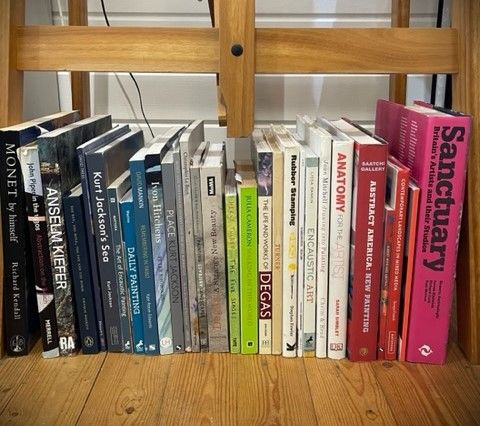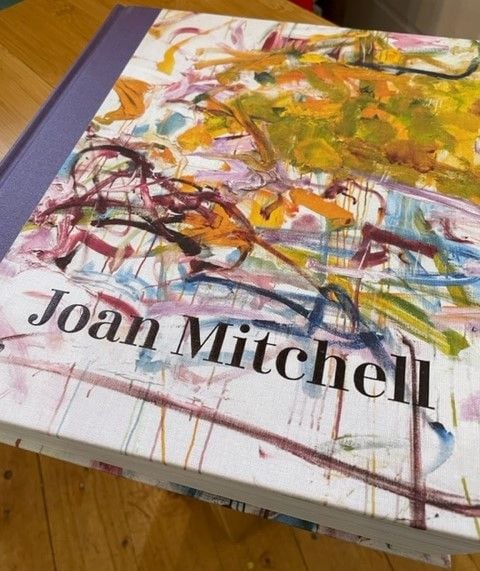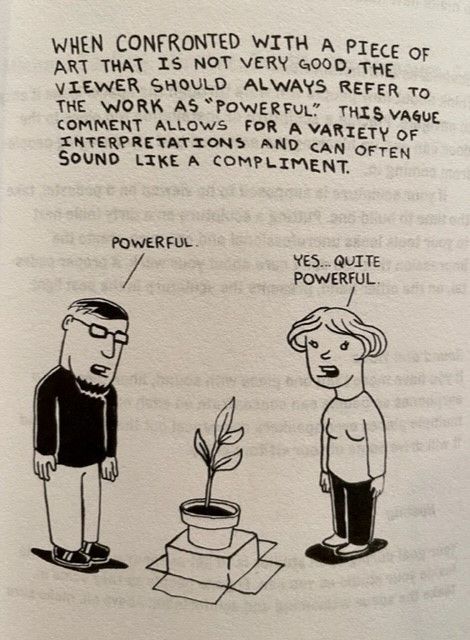Books on art and artists
Posted on
When I’m taking a lunchbreak in my studio, I make it a practice to read inspiring or art related books so my focus is always on art and not distracted by other things. When I’m procrastinating, I’ll tidy them up in colour order! Here's a little walk through some of my favourites on the book shelf.

Some of these books are big door-stoppers, bought from art exhibitions that have left a positive impression on me. I read them over the course of a few weeks, getting inside the head of the artist and trying to skim across all the institutional art babble that distracts me from making my own judgement about the work. I like to understand some of the background and related art history, but mostly I want to know why the artist made those decisions, how they managed their lives and what helped or hindered them.
I’m currently working through Joan Mitchell by San Francisco Museum of Modern Art with Yale University Press. I’ve read a lot about Joan, so skimming a little, but looking for juicy nuggets of words and relishing all of the long fold out pages designed for her beautiful quadriptych paintings.

Joan Mitchell also features in ‘Ninth Street Women’ by Mary Gabriel. A chunky novel of a book which captures the passionate feisty lives of five female artists in post-war America. I totally loved reading this and realised this was what I have searched for in every art history book I’ve read – the story of the women artists. What it means to struggle in a male-dominated art world, navigating critical life choices relating to children, love and financial security whilst pursuing your art relentlessly. It’s an interesting historical piece, but don’t be put off by the 926 pages as it’s totally relatable.
I have a few artist classics from the ‘How to’ genre. Some are helpful and others less so. They seem to fall into two camps of either practical advice for being a professional artist or emotional guidance on how to keep yourself relatively sane in the process.
Early in my career I bought a copy of Art/Work by Heather Darcy Bhandari and Jonathan Melber. This promises to tell you ‘Everything you need to know (and do) as you pursue your art career’ It does, to a certain extent, offering practical advice with examples or diagrams showing how to package and ship your paintings, how to produce a Consignment note and everything you might need to know about the artist/gallery relationship. The downside is that it’s based on the American system and not all countries follow the same dialogue, but it was something I could adapt and learn from. It gave me a different perspective and encouraged me to have a more professional approach. It also has fun cartoons!

If you are looking for tips on how to lead the life of a professional artist, ‘Ways of being’ by James Cahill is also worth buying, if just for the joy of the perfectly aligned circular cut-out tabs on each page. It feels very current and from the horse’s mouth, as it’s essentially a well-curated compilation of quotes by established artists on a time line of their career trajectory. This would be useful and relevant to any practicing artist and it’s always good to read about others who have struggled and then gone on to succeed.
I found Jerry Saltz’s ‘How to be an artist’ a little over hyped, full of quotable one liners but not that useful. I did really enjoy reading ‘Clear Seeing Place’ by Brian Rutenberg. It feels like walking through a series of conversations with him in his studio and is packed with anecdotes, motivating and cheeky ideas and practical tips covering everything from being your own fake publicist, to which colours are best for glazing. Worth a read.
I like a daily ritual to get me in the mood for painting, but I also like to shake things up. ‘Daily Rituals’ by Mason Currey I found too padded out and riding on the names of a famous few. It’s Ok to dip in and out of but not really worth the effort.
Moving on to books that provide emotional guidance, I should probably mention the well-respected Julia Cameron. I bought a copy of ‘Walking in this World’ in a second-hand book shop and having never read any of her books, I gave it a go. It’s a too little dreamy for me; I didn’t feel inspired to do the exercises or have an ‘artists date’, but the reading experience was made much more amusing by all the sweary, frustrated annotations scribbled amongst pages by the book’s previous owner!
‘Art & Fear’ by David Bayles & Ted Orland is popular and packed with comforting wise words of advice, but it didn’t speak to me in the same way that the more light-hearted ‘Big Magic’ by Elizabeth Gilbert did. (Can I mention her without mentioning ‘Eat, Pray, Love’?)
Perhaps it is the female perspective that makes this connect with me, but it made me laugh out loud and has more pages turned at the corner for quick reference than any other in my studio. It sits where I can pick it up in times of need and never ceases to motivate me to get back to work – it’s a kick up the backside on paper. This is the book I most often recommend to struggling artists.
There are too many fabulous anecdotes and memorable excerpts to quote from, but I particularly like her visualisation of the ‘Patron Goddess of Creative Success..a rich capricious old lady..who makes really weird decisions. She sometimes rewards charlatans and ignores the gifted. She cuts people out of her will who loyally served her for their entire lives, and then gives a Mercedes to that cute boy who cut her lawn once.’ When you’re traversing the minefield of galleries and clients this offers a refreshing reminder that the art world is a strange but wonderful place.
A while back I also bought ‘Daily Painting’ by Carol Marine as I know artists who have changed their entire practice after reading this and several of my students had recommended it. It is aimed at the still life or ‘Plein air’ painter but the practical recommendations on colour and composition would be useful to anyone. Her approach to painting, promoting and selling her work on a daily basis is refreshing but doesn’t give you any time as an artist to explore and develop new ideas in depth or work on collections of larger paintings. As an approach it’s simple, effective and clearly enjoyed by many, even if it’s just for a ‘painting a day’ month long project. It could be a great way to get you working fast and productively.
I should also mention ‘The Creative Habit’ by Twyla Tharp. Written from her perspective as a choreographer, she offers a dynamic insight into her creative process and the ups and downs of dragging an idea from initial spark to completion, with all the hurdles along the way. She offers great practical advice on how to collaborate with others and manage your time. I loved her suggestion to ‘pick a fight’ with your work and yourself. If you usually do things one way, do the opposite, embrace change and disturb your daily rituals.
I’m currently dipping in and out of fellow artist, Gareth Edward’s first book ‘Painting Abstract Landscapes’ written in conjunction with his daughter Kate Reeve-Edwards.
It’s a journey through some of the practical processes of oil painting in a contemporary style, sprinkled with art knowledge. If your Italian is a little rusty but you’re interested in learning about ‘Tenebrism’ and ‘Sfumato’ all these painterly terms are explained. The message is very much about establishing ‘Abstract Landscapes’ as a genre and it’s an insight into Gareth’s process. There are also some reviews of other artists currently practicing in the abstract landscape style.
If you’re interested in learning more about colour, the essential read is, of course, Josef Albers ‘Interaction of Colour’.
It’s a technical guide to his lengthy explorations and filled with weird looking visuals comparing colours in juxtaposition. He’s done all the hard work to figure out the relationships for you, so it’s worth persevering with the read. All this technical knowledge can only result better and more confident colour choices.
If you need a practical guide to navigating the world of Acrylics and discovering what to do with all those tempting pots of mystery in the art shops, then look no further than Patty Brady’s ‘Rethinking Acrylic’. It’s an artist’s bible packed with knowledge of all the gels, mediums and pastes available and a wide range of techniques you can use in your paintings. It's thoughtfully ring-bound to survive frequent use in the studio.
Patty was the Working Artist Program Director for Golden Paints so she knows her acrylics. With her pink hair, cat’s eye glasses and a penchant for breaking at three o’clock for wine, she made quite an impression on me, when I trained with her in London for the Golden Artist Educators program. I didn't like to guess her age; it seems that when you’re an artist, things just get more exciting the older you get, so there’s hope for us all. Her hair seems to change colour as much as her paintings; here's a younger photo of her from the book rocking an orange and black vibe.
Much like painting, it is such a personal thing whether you respond to a book or not and these are just my own opinions. If you have a favourite book to recommend, please mention it in the comments. I’m always keen to learn more and discover new favourites.
Happy Reading!

Add a comment: